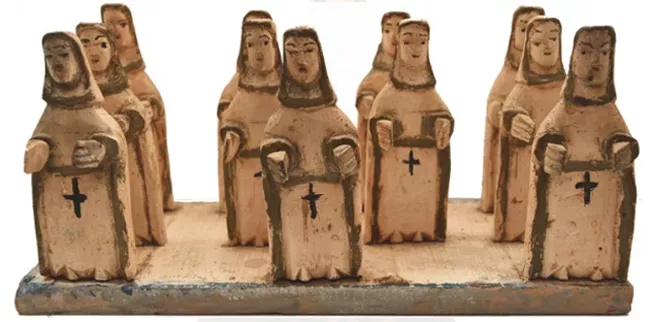The History of Santos in Puerto Rico
Walk around the souvenir shops of Old San Juan and you’re bound to see them: hand-carved figurines, usually made of wood (santos de palo), of saints or other religious figures. These are the santos of Puerto Rico, and they are the product of an island tradition that goes back centuries. Santos are common throughout the Latin world.
The larger santos are made for churches, while smaller ones that you’ll easily find in shops and galleries are meant to be placed in a household. In Puerto Rico, almost every home has a santo. Many Puerto Ricans place their santos inside a wooden box with folding doors, called a nicho, and use them as altars where they place offerings or address their prayers.

The santos tradition has been alive in Puerto Rico since the 16th century. They originally served a practical purpose: for home use in rural areas that had limited access to churches. There’s a santo from Puerto Rico in the Smithsonian’s Museum of National History that dates to the 1500s. Initially, santos were carved out of a single block of wood; only later did the craft become more sophisticated, with separate pieces assembled together to make the finished product.
Santos are hand-carved by artisans known as santeros. Using a simple knife, these artisans (many of whom are honored as master craftsmen on the island) typically paint and sometimes adorn their creations with precious stones or filigree. They then use a mix of wax and chalk to fashion the head and face of the saint.
While the larger creations intended for churches are often more elaborate, in essence, the craftsmanship of santos follows a simple aesthetic; quite the opposite of vejigante masks, which come in a wild conflagration of color and fantasy, santos (at least, the smaller ones made for private homes) are made with a humble touch and homespun beauty. Similarly, santos are usually not depicted in pious poses, their eyes raised toward the heavens or radiating an aura of benevolence or in an act of suffering or martyrdom. Rather, they are carved in plain upright poses, or riding on horseback or camel-back in the case of the Three Kings. It is this subtlety and simplicity that give santos both their elegance and their spiritual essence.

A ‘Rican Souvenir
Santos play an important role in the lives of Puerto Ricans (and Catholic people throughout Latin America), but they also make for a wonderful keepsake of your time on the island. Like many arts and crafts, they range from crude, cheap carvings available for just a few dollars to lovely historic treasures worth a pretty penny. If you’re seeking affordable options, walk into practically any souvenir shop in San Juan and you’ll find them. For the latter, it’s important to look for the signature of the artist. The well-known santeros always sign their work, proving its value and serving as a clear mark of fine craftsmanship.
In Old San Juan, there are a few places where you’ll find fine examples of santos. Galería Botello on Cristo Street has a magnificent collection of santos, many dating from the 1900s from famed workshops around the island. I’ve also seen a small but worthy display (for sale) at the Siena Art Gallery on San Francisco Street, one of many in the city.
You can also check out the virtual museum of santos for a terrific overview of this tradition, fine examples of Puerto Rican santos, and interviews with santeros.
The most ubiquitous santos are of the Three Kings (either on foot or on horseback) and many iterations of the Virgin Mary. If they pique your interest, enjoy exploring the souvenir shops in the city to find one that speaks to you.





